Siena:
Medieval Italy at its Best
by Peter Flaherty ![]()
Often overshadowed by its
more famous neighbour and long-time rival Florence, the Tuscan city of
Siena, located in central Italy, is a gem of medieval architecture, and
a destination deserving of far more than the day or two most tourists
devote to it. Dramatically located in the beautiful, rolling Tuscan countryside,
Siena is one of those increasingly rare places in the world today where
one can truly feel a sense of time standing still.
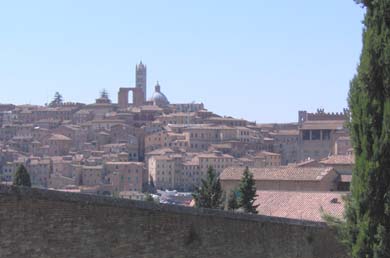
The old town has been preserved in all its medieval and Renaissance glory, and the absence of cars from many of its narrow, winding streets allows the unhurried visitor a wonderful opportunity to explore its more famous sites along with less-well-known byways. The people of Siena are justifiably proud of their city, and are equally determined to preserve its long-standing traditions and ways of doing things.
As a recent guide to the city notes, “Siena takes pride in inverting ways of thinking and acting that are accepted in the rest of the world. It is a city that lives the sensation of doing the opposite of what others do. Here, logic, even deadly common sense and everything that makes the world more and more alike, go backwards.”
For the past three summers, I have had the pleasure of coming to know Siena on an ever more familiar, or even intimate basis, by teaching summer courses to Canadian students there. When classes end at noon every day, I eagerly take a local bus from our hotel, the Vico Alto, located just outside the old city walls, and begin yet another exploration of Siena’s riches on foot. While it is possible to access parts of the city by car, by far the best way to appreciate it is as a pedestrian. Many of the streets are far too narrow for motor vehicles anyway, and unless one is a native, navigating the labyrinthine twists and turns of the medieval heart of the city might prove a very daunting and nerve-wracking task, especially for the uninitiated.
Although some locals like to trace their city’s origins back to the Roman empire, Siena’s history really dates from early medieval times, when the city rose to prominence and prosperity because of its location on a major trade route from Rome to France, the “via francesina”. It was during this medieval heyday that the local population developed a strong sense of civic identity and pride, and a form of government that was remarkably democratic for its time began to emerge. Everywhere one looks in Siena, one can see the concrete traces of the city’s period of economic, political, and cultural magnificence. And local residents continue to preserve their proud heritage by observing a number of rituals that celebrate its history, traditions, and civic pride. The oldest bank in Europe — and perhaps even the world — for example, the Monte dei Paschi di Siena, was established here in the 14th century.
The heart of Siena is the Piazza del Campo, or “Campo” for short, considered by many to be the most impressive public square in all of Italy. Designed in the shape of a scallop shell, it was originally laid out in the 14th century by the local government, the“ Council of Nine.” Flanked on all sides by public buildings, restaurants, cafés, and shops, the empty space of the square itself is divided into nine pie-shaped sections, whose apex points meet at the Palazzo Pubblico, or city hall, where the Council of Nine once held its deliberations. The Campo is Siena’s main meeting-place for both locals and tourists alike, where it is possible to stretch out on the cobble-stone pavements and admire the view, or just rest for a while, perhaps enjoying a delicious gelato (ice cream) from one of the nearby shops. One can also take in the scene from a café, where a beer or coffee may be a bit more pricey, depending on whether one chooses to stand at the bar, sit inside, or take the most popular tables outside.
Facing the Palazzo Pubblico across the square is the ornate and impressive Fonte Gaia (“happy fountain”), which first bubbled forth in 1346 as a public works project initiated by the Council to provide the Sienese with a supply of fresh, free drinking water. The intricately carved panels on the fountain are reproductions of marble originals by Jacopo della Quercia, a famous Sienese artist and sculptor of the early 15th century. The originals are still to be seen at the museum complex housed in Santa Maria della Scala, once a medieval hospital, an easy walk from the Campo and just across from Siena’s great cathedral. This complex also includes a recently opened archaeological museum, containing artifacts dating back to the time of the Etruscans, the pre-Roman civilization that once dominated central Italy, and from whom the name “Tuscany” is derived.
Adjoining the Palazzo Pubblico is the famous bell tower known as the Torre de Mangia, built in 1344. Local legend has it that it takes its unusual title from the nickname of one of its better-known medieval bellringers, which later came to be used for the mechanical device installed to strike the hours. “Mangia” means “eat” in Italian, and as legend has it, the bellringer was very fond of his daily meal! The tower is 102 metres high, and is perhaps Siena’s most famous landmark, being visible for miles around from the countryside. It is possible to climb the tower, and from the top the medieval heart of Siena stretches out on all sides, offering the determined (and physically fit) visitor a truly breathtaking view of the city and its spectacular surroundings.
Inside the Palazzo itself, the Museo Civico (civic museum) is well worth visiting. One of its most interesting features is its frescoes. Medieval Sienese artists were especially skilled at this form of painting, which involves the application of paint to plaster when it is still wet in order to give the resulting colours a freshness and vibrancy not obtainable on canvas.
The frescoes on view here include the powerful and impressive Maesta (majesty) fresco painted by Simone Martini, located in the Sala del Mappamondo (map room). But perhaps the most fascinating fresco, at least for those with a penchant for politics, is Ambroglio Lorenzetti’s series provocatively named “The Allegory of Good and Bad Government.” One part of the wall portrays a number of scenes of peace and prosperity, with medieval peasants, merchants, tradesmen, and nobles going about their business in a productive and unthreatening way, as a medieval Sienese might have liked to imagine his town. But on the other side one can see the opposite — disturbing images of vice, cruelty, corruption, and crime that stem from bad government. As a piece of medieval political commentary (or propaganda?), these frescoes still strike a responsive chord with modern visitors who are perhaps all too familiar with the effects of good and bad government in their own countries.
During the Middle Ages, Siena was one of the most powerful and important urban centres in central Italy. It took the side of the Holy Roman Emperors against the popes based in Rome during the long-running conflict for supremacy between these rival secular and sacred political forces. As a result, it was drawn into a series of violent clashes with Florence, whose rulers strongly backed the popes.
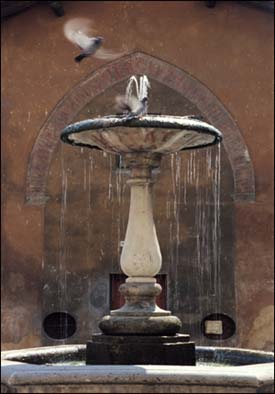
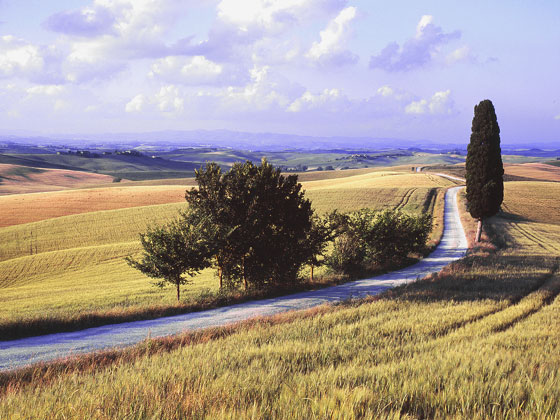
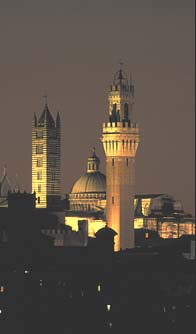
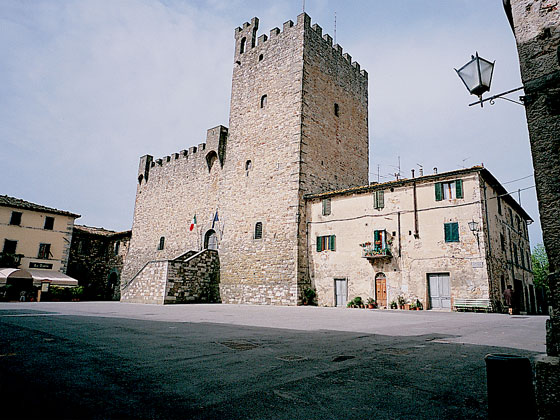
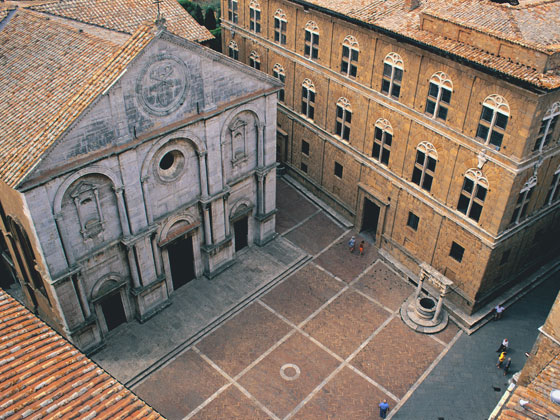
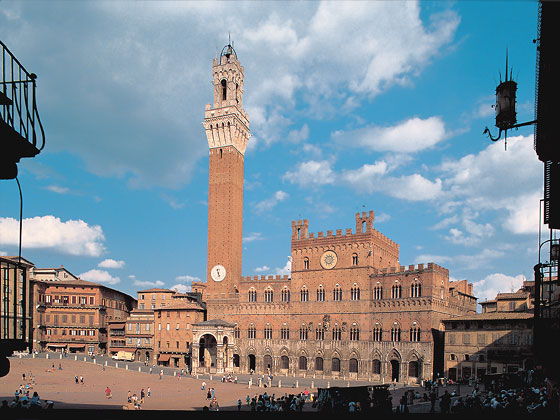
For Siena, the high point of this rivalry occurred on September 4, 1260, at the Battle of Montaperti, fought just south of the city. On that famous day in the annals of Sienese local history, their army trounced their Florentine rivals, and asserted the supremacy of Siena throughout Tuscany. However, Siena’s period of greatness was later to come to an end, as the effects of the Black Death of the mid-14th century devastated the city. But of far more importance was the fact that unlike Florence, located on the River Arno, Siena lacked a reliable supply of fresh water. As trade and commerce developed, this water shortage became acute, since waterpower was the main energy source to run mills and factories.
To compensate for this, local engineers constructed a series of elaborate tunnels that could be used to bring water into the town from the outlying hills. The workers started from opposite directions –one group 16 km. away, at the source of the water outside the town, the other in the heart of Siena itself. The two teams were totally unable to communicate with each other, and only had plumb lines and pick axes as their tools. Working in the dim light of oil lamps, they were able to construct a series of precisely designed tunnels, sloped at a low gradient that allowed the water to flow freely at a constant rate into the town. Over seven hundred years later, this network of water tunnels is still working, providing water to the many impressive fountains that dot the town. One of them, located underneath the popular Nannini ice cream and pastry shop, is used to this day to cool the fridge. This is just one of many examples testifying to the fact that Siena’s medieval heart is still beating strongly, fuelling the pride and satisfaction of the local residents. It is possible to arrange a tour of the tunnels with the local tourist office, located in the Piazza del Campo.
Every summer, on July 2 and August 16, Siena hosts an event that attracts thousands of visitors to the Campo. This is the world-renowned Palio, a horse race that is perhaps the most powerful and fascinating symbol of Siena’s medieval heritage and how it continues to live on today. Since medieval times, Siena has been divided into 17 contrade (wards), each one assuming responsibility for local affairs, and sending representatives to the local town council. The residents of each contrade adopted its own colours and symbol to represent them in the annual Palio. Among these are animal symbols, including the dragon, snail wolf, unicorn, giraffe, panther, rhinoceros, and caterpillar. As one explores the medieval heart of Siena, it is possible to determine which contrada one is in by noticing the brackets of the street lamps attached to the walls of the old buildings. Each of them is painted in the colours of the contrada, and shaped in the form of its mascot.
To the Sienese, one’s contrada is like an extended family. Even if they move from the neighbourhood of their birth, perhaps into the suburbs that now ring the old town, local residents stubbornly preserve their passionate identity with their contrada. As Giancarlo, the chef of the Hotel Vico Alto, explained to me during my visit, the contrada represents the focal point for one’s Sienese identity. Should one encounter difficulties with employment, finances, or even personal affairs, one has only to turn to one’s fellow contrada members for assistance, and it will be offered without question.
The competition pitting the different contrade against each other in the annual Palio is the high point of Siena’s civic life. It is a ceremony rich in history, tradition, and custom, and it basically brings the entire city to a standstill for days before it takes place. More than just a horse race, the Palio is an occasion for processions, parties, music, dance, and much good eating and drinking of fine local wine. The Palio derives its name from the prized object of the competition –a rich piece of cloth padded with fur called a “pallium.” The entry of the pallium, carried proudly on a horse-drawn carriage, into the Campo, is one of the high points of the day’s festivities. But the planning and execution of the Palio can take up weeks of detailed preparations before the event itself is staged in the Campo.
Only ten of the 17 contrade may participate in any given Palio. The successful competitors are chosen by lot, with the seven not selected given the first chance in the next draw. As soon as a contrada is chosen to enter a horse, then its local governing body goes into high gear, selecting a horse, hiring a jockey, and psychologically preparing its members for the important challenge awaiting it. Each Sienese contrada has its own church and museum, and these sites become hubs of frantic activity during the weeks leading up to the Palio. Experts in horsemanship carefully eye the available steeds and riders, and large amounts of money have been known to change hands to ensure a potentially successful mount and jockey for the contrada. A few days before the Palio, the horses and their riders are presented to the crowds assembled in the Campo. From there, they are escorted to their respective contrade, where the animals are housed in the local hearquarters, in sumptuous surroundings more befitting a medieval lord than a racehorse. Special grooms known as “barberischi” are chosen to take care of the prize animals, preparing them for the race that awaits them. The horses are even blessed by priests called “correttore”, who seek divine blessing on their fortunes in the Palio.
On the day of the Palio, crowds of Sienese, Italians from other parts of the country, and tourists throng the Campo, arriving hours before the race in order to obtain the best possible view. Standing for hours in the hot sun can take its toll on all but the most dedicated Palio watchers. By far more comfortable are the seats located in the bars and cafes fronting the Campo. But even if it is possible to reserve one of these prime-viewing locations, one can expect to pay at least four to five hundred dollars for the privilege.
As part of the “warm up” show, colourfully-dressed residents of the participating contrade parade around the square, eagerly showing off their prowess in drumming and baton-wielding, accompanied by bands of musicians playing instruments dating from medieval times. At 7:45 pm sharp in July, and 7 in August, the jockeys and their mounts, which they are riding bareback, congregate at the starting line. When the signal is given, they start out, frantically racing three times around the Campo, which has been covered with sand for the occasion. The jockeys use every trick in the book in order to gain advantage over their competitors, including hitting them with their whips. If a rider is thrown, the horse may continue riderless, and some Palios have been won this way! The only rule in the race is that jockeys may not interfere with the reins of other riders.
Once the winning horse has crossed the finish line, with or without its rider, the members of that contrada explode in a truly startling demonstration of euphoria at their triumph. The winning horse and jockey are paraded in triumph back to the contrada’s headquarters, where a noisy victory party begins, complete with feasting, drinking, and dancing. People from other contrade are invited to attend, provided they bring gifts to the winners. The party goes on for hours, and the city does not quiet down until near dawn on the following day. A victory in the Palio gives the residents of the winning contrada a sense of joy and pride that they cherish and commemorate for decades after the victory. It is by far the most important event taking place in Siena, and is something that links today’s residents of the city to their colourful, proud medieval past. A recent film called “The Last Victory” follows the story of one Sienese contrada in their quest for a Palio win, something that has eluded them since the 1970s. It is a wonderful introduction to this event, and its immense symbolic value for the people of Siena.
Siena is rich in churches, museums, art galleries, and other sites of interest to tourists. But perhaps the best way to enjoy the city and gain a real feel for its medieval atmosphere is just to stroll its narrow, winding streets, without worrying about getting lost. The areas nearest to the Campo and the Cathedral tend to be the busiest, especially when throngs of day-trippers arrive on summer afternoons. At these times, the visitor may feel almost as crowded as one does in Venice, as people compete for the best places to take photos o the magnificent square from adjoining streets and stairways. But within a few minutes’ walk of the main tourist sites, it is possible to find interesting, tranquil neighbourhoods, where local residents carry on their daily lives almost as if the tourist invasion was taking place in another city altogether.
Of course one should not miss Siena’s impressive Romanesque cathedral, or Duomo, begun in 1196 and completed in 1215. Its exterior façade is made of green, white, and red marble, in a style that is only found in Tuscany. In 1339, as part of their intense competition with their Florentine rivals, the people of Siena began a massive expansion of the cathedral, designed to make it the largest church in Italy. However, the Black Death, which struck the city a decade later, put a stop to the renovation plans. But local residents to this day are convinced that the real reason that Siena was not able to finish the additions to the cathedral lies in a Florentine plot to thwart their ambitions. According to Giancarlo, who like many Sienese prides himself on his knowledge of the city’s history, Siena had effectively sealed its residents from contamination from the plague by strictly closing their city off to outsiders. But a group of Florentines arrived outside the city walls late one night, and under cover of darkness used a catapult to launch a plague-infected cadaver into the city, thus causing a fatal outbreak of the disease and an end to the new cathedral’s construction. This is a story that I have not been able to confirm in any written source, but it certainly reveals how deep and long-running Siena’s rivalry with its neighbour is, to the present day!
The interior of the cathedral is even more impressive. Its most beautiful feature is the inlaid marble floor, intricately decorated with a series of 56 panels depicting Biblical and classical themes. Many of them are covered for parts of the year, in order to protect them from visitors’ footsteps. But by late summer, most or all of these magnificent panels have been uncovered for public view. The cathedral complex includes a small papal library off its north aisle, a museum containing a number of works from by medieval Sienese painters on religious themes, and the Gothic Baptistry, whose prize possession is a marble fount carved by Jacopo della Quercia. But one of the best attractions offered is the panoramic view one can obtain by ascending a narrow flight of stairs to the roof of the cathedral museum. This climb is definitely not for the clautrophobic, but once at the top, the views of the city are perhaps even more magnificent than one can have from the Mangia tower.
Apart from the cathedral, Siena is rich in other churches. One of the most interesting is San Domenico, located in the northwestern corner of the town. An imposing, 13th-century Gothic building with a barn like interior, it contains a number of frescoes depicting scenes from the life of one of Siena’s most famous residents, St. Catherine of Siena. St. Catherine was born to a humble family in the Fontebrada quarter of town, but through her work with the poor she rose to a position of great religious influence. A woman never afraid to speak her mind, she corresponded with dukes, bishops, and even popes, offering them advice and even criticism on topics such as the Crusades and splits within the Church when the mood struck her. She died in Rome in 1380, but her mummified head and part of her thumb may still be seen on display in the church to this day, grisly reminders of the cult of holy relics that was so widespread in Italy and other Catholic countries during the Middle Ages. In 1461, Pope Pius II, a fellow Sienese from the influential Piccolomini family, canonized Catherine as a saint, and in the years that followed, throngs of pilgrims descended on Siena to pay tribute to her memory.
South of the Campo one finds another beautiful church, St. Agostino, designed by a Dutch architect employed by the King of Naples, with an ornate Rococco interior dating from the 18th century. Every summer, concerts are held in this church, presented by performers from Siena’s renowned school of music, the Academia Musicale Chigiana, which has its headquarters in a palazzo near the Campo. Besides concerts, this music school offers summer courses in classical music that are avidly attended by aspiring young musicians from all over Europe and North America. Last summer, I enjoyed some truly memorable concerts with works by Vivaldi, Pergolesi, and other great Italian baroque composers, performed by outstanding musicians and singers in the stunning and acoustically-perfect surroundings of the church.
But Siena has a more modern side too, often effectively combined with its medieval and renaissance atmosphere. Every summer, the city hosts a jazz festival, with concerts by internationally renowned musicians taking place in the Campo and other locations. One beautiful July evening I had the pleasure of listening to jazz diva Didi Bridgewater perform under a canopy of stars and an ultramarine-tinged sky as the Palazzo Pubblico and the adjoining buildings gleamed in a reflected rosy light. Jazz ensembles also perform in the charming outdoor wine bar housed in the Medici fortress on the northern edge of the old town. Even without music, this is a pleasant venue to sample the local Chianti or other Tuscan vintages, served either by the glass or in a bottle. Sipping a memorable local wine on a beautiful summer evening, as one takes in the sights and smells of the orange-yellow trumpet vines that spread down the thick walls of the fort is a truly memorable experience.
Should one be so inclined, it is also possible to share the uniquely Italian experience of watching a film outdoors, sitting on the stone seats of the amphitheater of the fortress. The movies are only in Italian, and are not usually dubbed or subtitled, but the experience is unforgettable nonetheless. One night I enjoyed watching “Sideways”, a film I had already seen, and was amused by the reaction of the local audience to a movie about another world-renowned wine region. The crowd was particularly amused by the fact that the daughter of one of the film’s main characters was named “Siena.”
The Medici fort is not one of Siena’s most favourite monuments, since it was built by the city’s Florentine conquerors once they had effectively crushed their rival in the 16th century. Every Wednesday, however, locals descend on the streets leading to it for a weekly market. Here it is possible to find great bargains on clothing, hardware, birds, plants, and fresh foods of all kinds. The market is a wonderful way to appreciate the daily life of the Sienese, since most tourists are not familiar with it. One can make a great snack or lunch from the fresh bread, cheese, meat, and tomatoes offered for sale there.
Another off-the-beaten-track lunch spot, located off one of the main streets leading north from the Campo, is the ironically named “Grattacielo”, or “skyscraper.” This tiny restaurant is the total opposite of “fast food”, and offers wonderful combination plates of antipasto items such as sun-dried tomatoes, cheese, sardines, potato salad, and cold cuts for ridiculously low prices. Once one has made a selection from the wide array of choices, it makes sense to step outside with a carafe of wine and take a seat on one of the benches placed on the street. There, perched precariously on a very steep incline as the road runs down to a small square nearby, one can have a real feel for the experience of Siena, since most of the “skyscraper’s” customers are locals, not tourists.
For fancier Tuscan-inspired fare, Siena is well-provided with small to middle-sized family-run restaurants where delicious pasta and meat dishes can be savoured, often while seated outside on a balmy summer evening, watching the tourists and locals walking by. One good bet is the Hostaria il Carroccio, located just south of the Campo, where the pici, a thick spaghetti covered in a meat sauce made from rabbit or wild boar, is recommended. The pork with fennel seeds is another signature dish at this restaurant, a proud member of the “slow food” movement that promotes locally produced food and wine. Tasty pizzas can be had at the Spadafina, a pizzeria facing the Campo. One of its most unusual varieties is the “cocaine” pizza, so called because one of its ingredients is hot pepperrs!
The excellent coffee and pastries at Nannini, mentioned earlier, are also not to be missed. Siena is replete with a number of small take-out gelaterie, or ice-cream stands, where the number of selections can sometimes seem mind-boggling. But usually the undecided customer can ask for a small sample before making a decision. Italian ice cream is deservedly famous, and nothing beats walking the streets on a warm summer evening, a cone or cup of delicious gelato in hand, taking in the sights of this beautiful medieval town at relaxed, unhurried pace.
Siena can be very crowded during the summer months, as visitors from other parts of Italy, Europe, North America and Asia flock to the city for the Palio. Many tourists only stay for a day, but some like to make the town a base for exploring the many fascinating little Tuscan hill towns that dot the surrounding countryside. Some of them, like Montalcino, Monteriggioni, or Castellina in Chianti, are an easy bus or car ride from Siena, and have much to offer, especially their many excellent varieties of local wines. Somewhat further afield, but still possible as day trips, are San Gimignano, with its 14 well-preserved medieval towers, and the fourteenth-century Abbey of Monte Oliveto with its striking frescoes painted by the renowned Sienese artists Sodoma and Signorelli. For those whose interests incline more towards natural scenery, the area known as le Crete, south of Siena, offers a relaxing change from the crowds that throng the Campo during the summer. With its rolling clay hills, solitary cypress trees, and the occasional farmhouse in the distance, this region makes a wonderful opportunity for a day’s drive and a picnic. It is also possible to take a nature train through the area that starts and ends in Siena, after travelling through the beautiful nearby towns of Asciano, Val d’Orcia, and Monte Antico..
Siena is well equipped with hotels of various categories from the budget to top end. It is advisable to book in advance, especially during the busy summer season. And anyone planning to visit the city during the periods of the July or August Palios should arrange accommodation at least a year ahead. Whenever you visit, however, a truly enjoyable trip back in time to the medieval period can be experienced, especially if you take the time to allow the city to work its magic on you, and explore areas where the day-trippers are unlikely to roam.
For More Information
Siena's official website has a wealth of information.
Unless otherwise indicated, photographs are courtesy of the Siena Tourist Office.